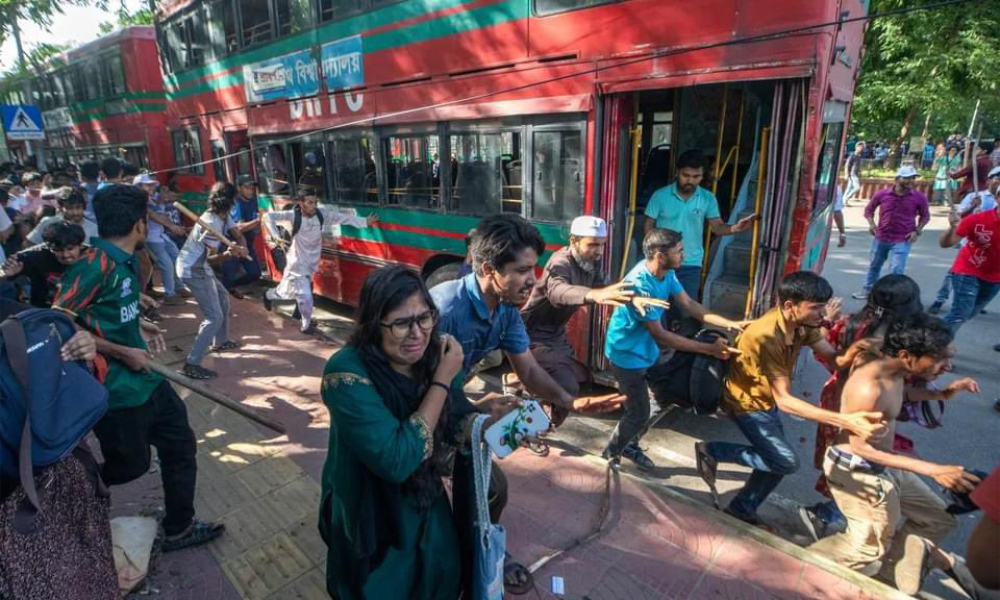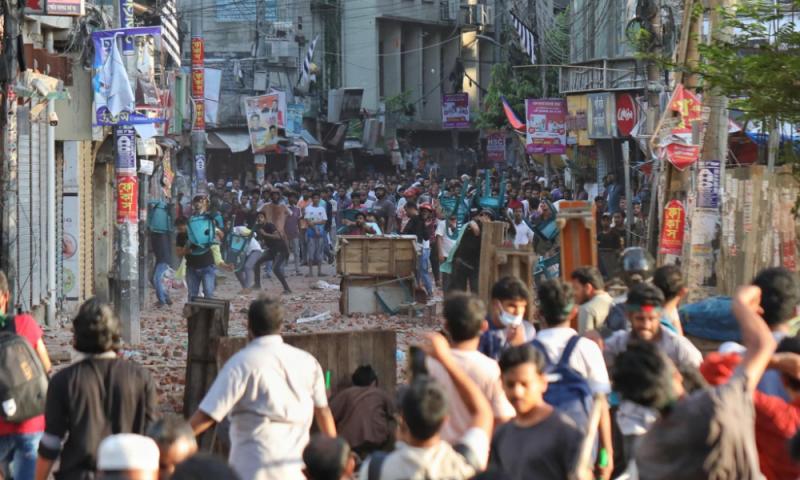Why are students in Bangladesh protesting job reservations?
It took nationwide protests, violent state and military intervention, and deaths of at least 139 people for the Supreme Court in Bangladesh to step in and scale back the reinstatement of controversial job quotas in the country that favours descendants of freedom fighters, women, and people from underdeveloped districts.
As of July 22, Bangladeshi media reported over a thousand had been injured in protests that were primarily peaceful and led by students. Last week, the police fired sound grenades, tear gas shells, and rubber bullets as they tried to quell their movement.
The government under Prime Minister Sheikh Hasina, who won an unprecedented fourth term this January, denied using excessive and indiscriminate force, but the death toll continues to rise. At least 50 people died on Friday.
At the moment, there’s an indefinite curfew, and internet and text message services have been suspended. Local media websites such as Dhaka Tribune, which is an Asian Dispatch member, are suspended too.
On Sunday, even though the country’s highest court directed a scale-back of quotas from 56 percent to five percent, news outlet BBC Bangla quoted some protest coordinators as saying that they will continue protests, especially to secure the release of detained student leaders.
Asian Dispatch breaks down the sequence of events to understand what led to the civil discontentment over the quotas, and what is the way forward for Hasina.
Why is the job quota system so controversial?
The quota system for government jobs in Bangladesh was created after Bangladesh won its independence from Pakistan in 1971, a movement that was led by Sheikh Mujibur Rahman, who is widely considered the father of independent Bangladesh. He is also Hasina’s father.

Rahman himself started as a student activist during British rule. After independence, in 1972, it was his government that introduced job quotas for freedom fighters. Back then, too, it was met with heavy resistance, especially from the University of Dhaka which demanded merit and equal opportunity.
The quota system, ubiquitous across South Asia, is designed to be affirmative action to bring more representation in the employment sector. In Bangladesh, job quotas are especially coveted because of the promise of better pay and job security. However, government data shows that the number of Bangladesh’s working population is increasing, but the jobs aren’t.
The original quota system reserved 30 percent of jobs for veterans of the Bangladesh Liberation War and their descendants, while 10 percent were for women who survived mass sexual violence by the Pakistani army during the war, and 40 percent for those from underrepresented districts. Over the years, these quotas have been modified. But it remained controversial.
Since 1971, the number of freedom fighters and their descendants has dwindled, leading to many job-seekers questioning the need for such a high number in reservations. There have been accusations of misuse and corruption in how these quotas are being sought. Many critics blame the system for benefitting those close to the ruling party.
Bangladesh’s unemployment rate, according to an official survey done between January and March this year, is 3.51 percent, amounting to 25 lakh (2.5 million) unemployed out of the country’s total population of 17.12 crore (171 million). As of now, only 44 percent of government jobs are allocated based on merit.
But this isn’t the first time students have come down to the streets to demand quota reforms.

In 2018, after Hasina confirmed she would keep the job quotas, university students led nationwide protests demanding job quota reforms. Hasina’s government immediately cracked down on the movement, but a few months later, she issued an executive order to remove all job quotas entirely. In 2020, the decision to abolish the quotas became effective.
However, this June, the Bangladesh High Court cancelled the government notification, declaring it illegal, and reinstated the quotas, resulting in ongoing mass protests.
How did the protests get violent?
The protests started on July 1 by students of the University of Dhaka who demanded that the quota system be modified to reflect the needs of present-day Bangladesh. Soon, students of other universities joined in. Right now, the movement is led by an umbrella organisation of students called the Anti-Discrimination Student Movement.
On July 14, Hasina, who staunchly supported the quotas, blamed the opposition for fuelling violence, and dismissed the demonstrators as “Razakars”, referring to a pre-independence paramilitary group with the Pakistan military who led a brutal campaign during Bangladesh’s freedom movement, which included widespread massacres of Bangladeshi freedom fighters and weaponising rape against women.
“Why do they have so much resentment towards freedom fighters?” Hasina was quoted as saying.
“If the grandchildren of the freedom fighters don’t get quota benefits, should the grandchildren of Razakars get the benefit?”
The students pushed back against Hasina’s remarks by adopting the term and raising slogans such as, “Asked for rights and became a Razakar!”
On Wednesday, July 17, the police used tear gas and sound grenades to break up a student demonstration at Dhaka University. Violence spread across the city, with retaliation by the government’s student wing Chhatra League, prompting the United Nations secretary-general spokesperson to urge the Bangladesh government to protect the students.

On Wednesday evening, Hasina addressed the nation and asked all sides to maintain peace until the Supreme Court’s verdict and blamed the deaths on “vested quarters.” At the same time, Asif Mahmud, a coordinator of the Anti-Discrimination Student Movement, called for a nationwide shutdown through a Facebook post.
In response, the state installed its paramilitary forces including Border Guard Bangladesh (BGB), Rapid Action Battalion (RAB), SWAT, and the Chhatra League. The RAB, which was set up by former prime minister Khaleda Zia, has been accused of extrajudicial killings and human rights violations in the past.
By Thursday, the state-backed crackdown saw the deployment of another 229 platoons of BGB.
Deadly clashes broke out in several parts of the city including Uttara, Mohammadpur Beribadh, and Merul Badda. Unknown persons broke into state broadcaster Bangladesh Television’s (BTV) headquarters in Dhaka and vandalised it.
Protesters also reportedly stormed a prison in central Bangladesh, setting hundreds of prisoners free. Reuters quoted Bangladesh’s attorney general AM Amin Uddin as saying that students were not a part of the violence and arson the country has seen since Monday.
On Friday afternoon, as the Dhaka Metropolitan Police (DMP) banned rallies and processions, a shoot-at-sight order was administered alongside a telecommunication blackout.
By the weekend, at least 139 people had been killed, including a journalist. As of July 23, local media remained largely silenced under the communication blackout. The student movement has pledged to continue protests and ensure the release of their imprisoned supporters, and to hold the perpetrators of violence accountable.
The original Supreme Court verdict on the quotas was scheduled for August, but this was pushed up to Sunday in light of the escalating situation.
Presently, the latest ruling will make 93 percent of job allocations merit-based, five percent will be reserved for descendants of Bangladeshi freedom fighters, and two percent will be reserved for ethnic minorities, transgender individuals, and the disabled.
This article was first published in Asian Dispatch. Read the original article here.
RM12.50 / month
- Unlimited access to award-winning journalism
- Comment and share your opinions on all our articles
- Gift interesting stories to your friends
- Tax deductable
